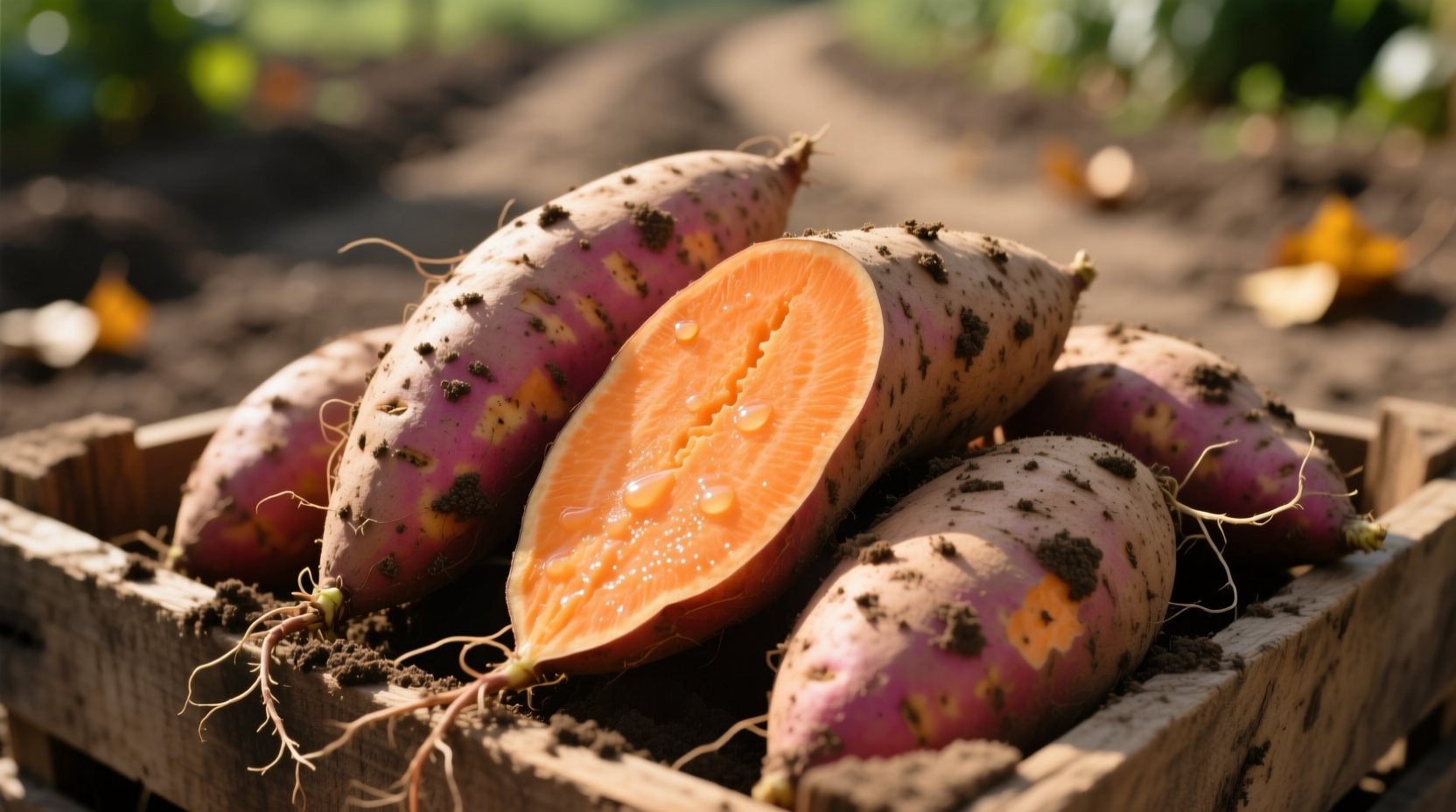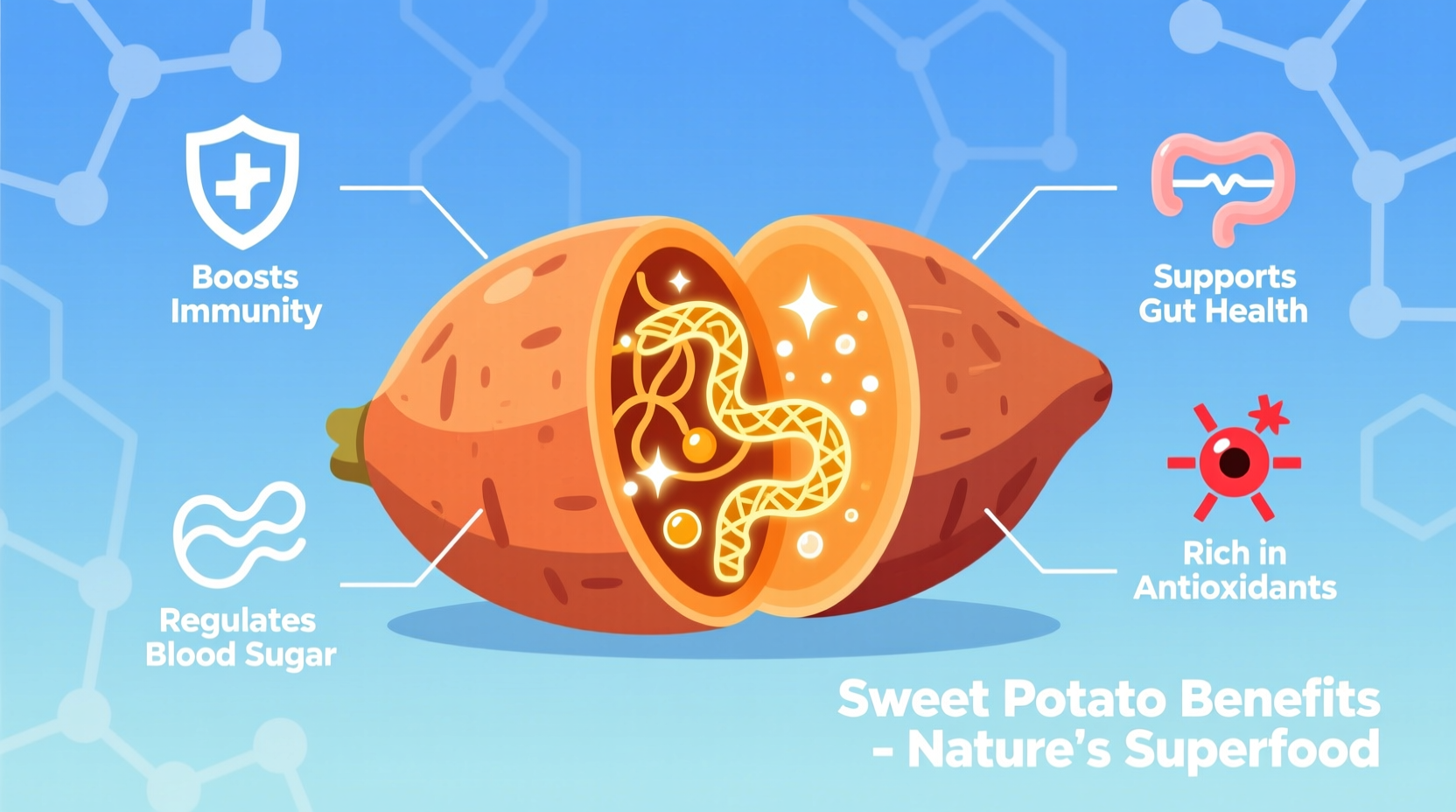Nutritional Powerhouse: Why Sweet Potatoes Stand Out
Despite their name, sweet potatoes offer remarkable health advantages that extend far beyond basic nutrition. Unlike regular potatoes, sweet potatoes rank among the top sources of beta-carotene, which your body converts to vitamin A—the nutrient essential for maintaining healthy vision, immune function, and skin integrity. According to USDA FoodData Central, a single medium sweet potato (130g) contains approximately 10,663 IU of vitamin A, fulfilling more than 400% of the recommended daily value.
| Nutrient | Sweet Potato (130g) | Regular Potato (130g) |
|---|---|---|
| Vitamin A | 400% DV | 0% DV |
| Vitamin C | 37% DV | 28% DV |
| Dietary Fiber | 15% DV | 8% DV |
| Glycemic Index | 44-61 | 72-85 |
This nutritional advantage stems from sweet potatoes' unique composition. The vibrant orange flesh indicates high beta-carotene content, while purple varieties contain anthocyanins—powerful antioxidants also found in blueberries. These compounds work synergistically to combat oxidative stress and inflammation throughout the body.
Blood Sugar Management: The Sweet Potato Paradox
Contrary to what their name suggests, sweet potatoes can actually help regulate blood sugar levels when prepared properly. Research published in the American Journal of Clinical Nutrition demonstrates that the high fiber content in sweet potatoes slows glucose absorption, resulting in a more gradual rise in blood sugar compared to regular potatoes.
The glycemic index (GI) of sweet potatoes ranges from 44-61 depending on preparation method, significantly lower than regular potatoes which typically score between 72-85. Boiling sweet potatoes preserves more of their natural fiber compared to baking or frying, making it the optimal preparation method for blood sugar management. The American Diabetes Association recognizes sweet potatoes as a diabetes-friendly food when incorporated into balanced meals.
Immune System Support Through Vitamin A
Vitamin A deficiency affects approximately 190 million preschool-aged children globally, according to the World Health Organization. Sweet potatoes represent one of the most accessible and affordable solutions to this public health challenge. The beta-carotene in sweet potatoes converts to retinol (active vitamin A) in your body, supporting critical immune functions.
National Institutes of Health research confirms that adequate vitamin A intake maintains the integrity of mucosal barriers in your eyes, respiratory tract, and gut—your body's first line of defense against pathogens. This explains why populations consuming sweet potatoes regularly show lower rates of infectious diseases in regions where vitamin A deficiency is common.

Digestive Health Benefits You Can Feel
The fiber profile in sweet potatoes offers dual benefits for digestive health. With approximately 4 grams of fiber per medium potato, they provide both soluble and insoluble fiber that supports different aspects of gut function. Soluble fiber forms a gel-like substance that slows digestion and feeds beneficial gut bacteria, while insoluble fiber adds bulk to stool and promotes regular bowel movements.
Harvard T.H. Chan School of Public Health research indicates that diets rich in fiber from whole foods like sweet potatoes correlate with reduced risk of diverticular disease, hemorrhoids, and colorectal cancer. The resistant starch content in cooled cooked sweet potatoes acts as a prebiotic, further enhancing gut microbiome diversity.
Heart Health Protection Through Potassium and Antioxidants
Sweet potatoes deliver approximately 10% of your daily potassium needs in a single serving—more than bananas by weight. Potassium helps counteract sodium's effects on blood pressure, making sweet potatoes valuable for cardiovascular health. The American Heart Association emphasizes potassium-rich foods as part of a heart-healthy diet.
Beyond potassium, sweet potatoes contain anthocyanins (in purple varieties) and chlorogenic acid that research shows may reduce inflammation markers associated with heart disease. A study in the Journal of Agricultural and Food Chemistry found that purple sweet potato extracts demonstrated significant antioxidant activity that could protect against LDL cholesterol oxidation—a key factor in atherosclerosis development.
Practical Integration: Maximizing Sweet Potato Benefits
To preserve maximum nutritional value when preparing sweet potatoes:
- Keep the skin on—nearly half the fiber and many nutrients reside just beneath the skin
- Boil instead of bake—boiling retains more beta-carotene (up to 92% vs. 70% with baking)
- Add healthy fats—pair with olive oil or avocado to enhance absorption of fat-soluble vitamins
- Cool before eating—cooling increases resistant starch content for better gut health benefits
For optimal storage, keep sweet potatoes in a cool, dark place (55-60°F) where they'll maintain quality for 3-5 weeks. Avoid refrigeration, which can cause hard centers and off-flavors. Never store sweet potatoes near onions, as the gases they emit can accelerate spoilage.
Contextual Considerations: When Sweet Potatoes Shine
While sweet potatoes offer numerous advantages, their benefits manifest differently depending on individual health contexts:
- For athletes: The complex carbohydrates provide sustained energy release during endurance activities
- For pregnant women: High folate content supports fetal development (especially important in the first trimester)
- For aging populations: Vitamin A and antioxidant content supports eye health and cognitive function
- For weight management: High fiber content promotes satiety with relatively low calorie density (about 103 calories per medium potato)
Limitations exist for certain populations: individuals with kidney disease may need to monitor potassium intake, and those with specific carbohydrate-restricted diets should account for sweet potatoes' natural sugars. Always consult with a healthcare provider about dietary changes if you have specific medical conditions.
Historical Journey: From Ancient Crop to Modern Superfood
Sweet potatoes have nourished human populations for millennia. Archaeological evidence from the Chimu culture in Peru dates sweet potato cultivation to approximately 1850 BCE. Spanish and Portuguese explorers introduced sweet potatoes to Europe and Asia in the 15th and 16th centuries, where they quickly became staple crops due to their adaptability and nutritional value.
During World War II, the United States government promoted sweet potatoes as part of the "Victory Garden" initiative to address food shortages. In the 1980s, NASA selected sweet potatoes as one of the ideal crops for potential space agriculture due to their high nutrient density and efficient growth characteristics. Today, sweet potatoes rank as the world's 13th most important food crop by monetary value, with global production exceeding 90 million tons annually according to FAO statistics.











 浙公网安备
33010002000092号
浙公网安备
33010002000092号 浙B2-20120091-4
浙B2-20120091-4